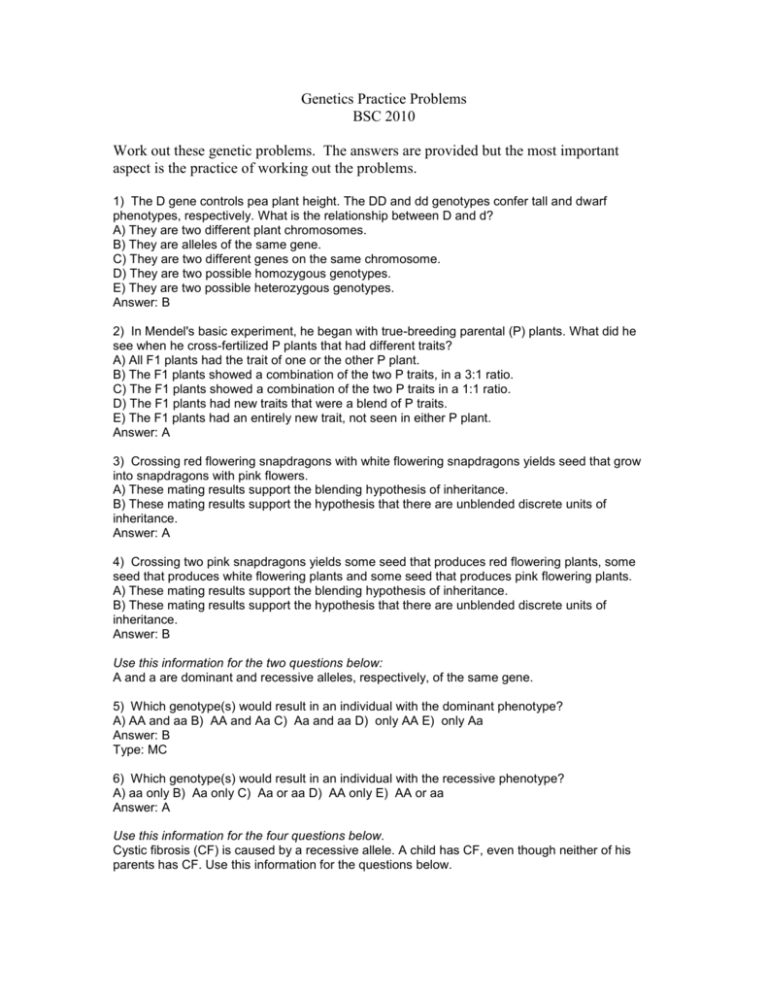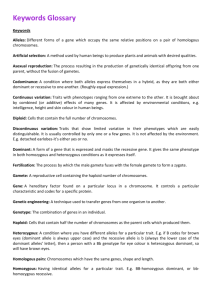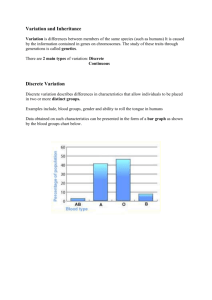Genetics Practice Problems
advertisement

Genetics Practice Problems BSC 2010 Work out these genetic problems. The answers are provided but the most important aspect is the practice of working out the problems. 1) The D gene controls pea plant height. The DD and dd genotypes confer tall and dwarf phenotypes, respectively. What is the relationship between D and d? A) They are two different plant chromosomes. B) They are alleles of the same gene. C) They are two different genes on the same chromosome. D) They are two possible homozygous genotypes. E) They are two possible heterozygous genotypes. Answer: B 2) In Mendel's basic experiment, he began with true-breeding parental (P) plants. What did he see when he cross-fertilized P plants that had different traits? A) All F1 plants had the trait of one or the other P plant. B) The F1 plants showed a combination of the two P traits, in a 3:1 ratio. C) The F1 plants showed a combination of the two P traits in a 1:1 ratio. D) The F1 plants had new traits that were a blend of P traits. E) The F1 plants had an entirely new trait, not seen in either P plant. Answer: A 3) Crossing red flowering snapdragons with white flowering snapdragons yields seed that grow into snapdragons with pink flowers. A) These mating results support the blending hypothesis of inheritance. B) These mating results support the hypothesis that there are unblended discrete units of inheritance. Answer: A 4) Crossing two pink snapdragons yields some seed that produces red flowering plants, some seed that produces white flowering plants and some seed that produces pink flowering plants. A) These mating results support the blending hypothesis of inheritance. B) These mating results support the hypothesis that there are unblended discrete units of inheritance. Answer: B Use this information for the two questions below: A and a are dominant and recessive alleles, respectively, of the same gene. 5) Which genotype(s) would result in an individual with the dominant phenotype? A) AA and aa B) AA and Aa C) Aa and aa D) only AA E) only Aa Answer: B Type: MC 6) Which genotype(s) would result in an individual with the recessive phenotype? A) aa only B) Aa only C) Aa or aa D) AA only E) AA or aa Answer: A Use this information for the four questions below. Cystic fibrosis (CF) is caused by a recessive allele. A child has CF, even though neither of his parents has CF. Use this information for the questions below. 7) What can you conclude about the parents? A) They are both homozygous dominant for the CF gene. B) They are both homozygous recessive for the CF gene. C) One is homozygous dominant for the CF gene, the other is heterozygous. D) One is homozygous recessive for the CF gene, the other is heterozygous. E) They are both heterozygous for the CF gene. Answer: E 8) This couple has another child who does not have CF. What is the probability he or she is heterozygous? A) 1/4 B) 2/4 C) 3/4 D) 1/3 E) 2/3 Answer: E 9) If this couple has another child, what is the probability he or she will NOT have CF? A) 1/4 B) 2/4 C) 3/4 D) 1/3 E) 2/3 Answer: C 10) If this couple has another child, what is the probability it will be a boy, with CF? A) 1/32 B) 1/20 C) 1/16 D) 1/10 E) 1/8 Answer: E 11) Widows peak hairline in humans is dominant to non-widows peak hairline. If a person has a widows peak hairline, what is his or her genotype? A) It must be homozygous dominant. B) It must be homozygous recessive. C) It is either homozygous dominant or homozygous recessive. D) It must be heterozygous. E) It is are either heterozygous or homozygous dominant. Answer: E Use this information for the four questions below. In humans, "unattached" earlobes are dominant over "attached" earlobes. "Widows peak" hairline is dominant over "non-widows peak" hairline. Use E and e for the earlobe phenotype alleles, and W and w for the hairline phenotype alleles. 12) A female and a male, both with unattached earlobes, have a child with attached earlobes. What is the probability their next child will have attached earlobes? A) 4/4 B) 3/4 C) 2/4 D) 1/4 E) 0 Answer: D 13) A female and a male, both with genotype EeWw have a child. What is the probability it will have attached earlobes and a widows peak hairline? A) 9/16 B) 3/16 C) 1/16 D) 1/3 E) 3/4 Answer: B 14) A female and a male, both with genotype EeWw have a child. What is the probability it will be a boy, and have attached earlobes and a widows peak hairline? A) 1/6 B) 3/16 C) 1/16 D) 1/32 E) 3/32 Answer: E 15) A female with unattached earlobes and a widows peak hairline and a male with attached earlobes and a widows peak hairline have a child. The child has attached earlobes and a nonwidows peak hairline. What are the genotypes of the parents? A) EeWw and eeww B) EeWw and eeWw C) EEWW and eeww D) EEWW and eeWw E) EeWw and EeWW Answer: B 16) What is the physical basis for the independent assortment observation that Mendel made? A) Male and female gametes are produced in separate organs in separate individuals. B) There are two chromosome divisions in meiosis. C) Recombination (crossing over) occurs in meiosis. D) Homologous chromosomes are randomly separated during meiosis I. E) Sister chromatids do not separate until meiosis II. Answer: D 17) The law of independent assortment states that A) in fertilization, the combining of sperm and eggs is random. B) in meiosis, crossing-over creates genetically diverse gametes. C) in any dihybrid cross, it is possible to get any combination of phenotypes. D) generation of male and female gametes must occur in separate organisms. E) in gamete formation, gene pairs are transmitted independently of each other. Answer: E 18) When Mendel crossed plants and followed two characters (a dihybrid cross), he saw a 9:3:3:1 ratio of characters in the offspring. What did he conclude? A) The transmission of one character is unaffected by the other. B) The two characters affect each other's transmission. C) Dominant characters are always more common than recessive ones. D) Characters are controlled by pairs of genes on homologous chromosomes. E) In meiosis, one allele of each gene is passed to each gamete. Answer: A 19) In a dihybrid cross, if heterozygotes are crossed, what fraction of the offspring are expected to have both the dominant phenotypes? A) 1/3 B) 2/3 C) 1/16 D) 3/16 E) 9/16 Answer: E 20) In the individual with genotype AaBB, what percent of gametes will contain the A allele? A) 100% B) 75% C) 50% D) 25% E) 10% Answer: C 21) How many different types of gametes can be generated by an individual with genotype AaBB? A) 1 B) 2 C) 3 D) 4 E) 8 Answer: B 22) What kind of phenotype ratio would you expect from a trihybrid cross? A) 1:1 B) 3:1 C) 9:3:3:1 D) very complex E) It cannot be determined. Answer: D 23) A "trihybrid cross" would A) follow a trait over three generations. B) follow three traits in a cross. C) be a cross involving gametes from three different individuals. D) follow a gene for which there are three alleles. E) follow a gene that affects three different traits. Answer: B Use this information for the seven questions below. In Mendel's pea plants, yellow seeds are dominant to green seeds. Purple flowers are dominant to white flowers. Use Y and y for the seed color alleles and P and p for the flower color alleles. Flower color and seed color assort independently. 24) If a true breeding green seed-producing plant is crossed to a heterozygous yellow seedproducing plant, what percent of offspring produces green seeds? A) 10 B) 25 C) 33 D) 50 E) 100 Answer: D 25) If a YyPp plant is crossed to a Yypp plant, what is the probability that the resulting plant will have the genotype Yypp? (Hint: Determine two separate probabilities and use the rule of multiplication.) A) 1/2 B) 1/4 C) 1/8 D) 1/16 E) 1/32 Answer: B 26) A plant of unknown genotype with yellow seeds and purple flowers is crossed to a plant with green seeds and white flowers. The offspring all have yellow seeds, but some have purple flowers and some have white flowers. What is the genotype of the yellow-seeded, purple-flowered plant? A) YyPp B) YyPP C) YYPP D) YYPp E) Yypp Answer: D 27) A true-breeding plant with green seeds and white flowers is crossed to a plant that is heterozygous for the genes for both phenotypes. What is the probability that the cross will yield a plant with green seeds and white flowers? A) 1/16 B) 3/16 C) 1/4 D) 1/32 E) 3/32 Answer: C 28) If a plant that is heterozygous for both flower color and seed color genes is self-fertilized, what proportion of the offspring will have one of the dominant phenotypes, either the seed color or flower color, but NOT both? A) 9/16 B) 6/16 C) 9/32 D) 6/32 E) 6/64 Answer: B 29) When Mendel crossed heterozygotes for flower color and seed color, what proportion of the offspring had both dominant phenotypes? A) 9/16 B) 3/16 C) 1/16 D) 1/3 E) 3/4 Answer: A 30) What is the relationship between the Y and P? A) They are two different chromosomes in the pea plant. B) They are incompletely dominant alleles of the same gene. C) They are two different genes on the same chromosome. D) They are the pleiotropic effects of a single gene. E) They are two different genes on two different chromosomes. Answer: E Use this information for the three questions below. A, B, and O blood type in humans is controlled by a single gene with three alleles: I to power of (A), I to power of (B) and i. 31) Imagine a fourth allele for blood type, I to power of (C). If it is also codominant with I to power of (A) and I to power of (B), and dominant to i, how many possible blood type phenotypes are there? A) 3 B) 6 C) 7 D) 8 E) 9 Answer: C 32) Type O is the recessive trait. The i allele is recessive to both I to power of (A) and I to power of (B). Which of the following could be possible genotypes of the parents of a person with type O blood? A) I to power of (A) I to power of (B) and ii B) I to power of (A)i and I to power of (B)i C) I to power of (A)i and I to power of (A) I to power of (A) D) I to power of (A) I to power of (B) and I to power of (A) I to power of (B) E) both parents must be ii Answer: B 33) A person with the genotype I to power of (A) I to power of (B) has type AB blood. This is an example of A) dihybridness. B) the effect of the environment on phenotype. C) codominance. D) pleiotropy. E) incomplete dominance. Answer: C 34) If a female who is a carrier for the hemophilia gene has a child with a male who does not have hemophilia, which prediction is correct? A) All of the sons and none of the daughters will have hemophilia. B) All of the daughters and none of the sons will have hemophilia. C) Half of the sons and half of the daughters will have hemophilia. D) Half of the sons and none of the daughters will have hemophilia. E) Half of the daughters and none of the sons will have hemophilia. Answer: D 35) A female who does not carry the color blindness allele has children with a male who is color blind. What proportion of their children will be color blind? A) all B) 1/4 C) 1/2 D) 3/4 E) none Answer: E 36) A female is not color blind, but half her sons are. Her daughters are not color blind. Which conclusion is correct? A) The father is color blind. B) The father is not color blind, but is heterozygous for the color blindness gene. C) The woman is heterozygous for the color blindness gene. D) Color blindness is dominant. E) Color blindness is autosomal. Answer: C Use this information for the question(s) below. A man and a woman are both carriers of sickle cell anemia. The man is color blind. The woman is not color blind, nor is she a carrier of color blindness. 37) How would the genotype of the man be written? A) Hb to power of (S), XY B) Hb to power of (A) Hb to power of (A), Y to power of (C)Y C) Hb to power of (S) Hb to power of (A), Y to power of (C)Y D) Hb to power of (S) Hb to power of (S), X to power of (C)Y E) Hb to power of (S) Hb to power of (A), X to power of (C)Y Answer: E 38) The proportion of all their children who will be carriers of color blindness who also have sickle cell anemia is A) 1/2. B) 1/6. C) 1/8. D) 1/16. E) 1/32. Answer: C 39) The percentage of all their children who will be color blind males with sickle cell anemia (meeting all three conditions) is A) 0. B) 10. C) 25. D) 33. E) 50. Answer: A 40) What proportion of their children will not have sickle cell anemia, yet will have malaria resistance? A) 1/2 B) 1/4 C) 3/4 D) none E) all Answer: A 41) A person who is heterozygous for the Huntington disease allele has offspring with someone who does not have HD. What proportion of their children will have HD? A) 1/16 B) 1/10 C) 1/8 D) 1/4 E) 1/2 Answer: E 42) What is a karyotype? A) a fetal cell B) a technique that obtains fetal cells for testing C) a test that determines if a cell is cancerous D) a test for the activity of amino acid synthesizing enzymes in a cell E) a picture of the set of chromosomes from a cell Answer: E 43) Which condition is caused by a chromosomal deletion? A) Down Syndrome B) Huntington disease C) Turner Syndrome D) cri-du-chat E) sickle cell anemia Answer: D 44) Why might a chromosomal duplication be harmful? A) It involves the loss of some genes. B) It changes the orientation of a chromosomal segment. C) It might result in production of too much of a protein. D) It adds so many chromosomes that they might not fit in the cell. E) It results in polyploidy, which is not tolerated by humans. Answer: C 45) People with Down Syndrome have A) a diploid set of chromosomes, plus one extra of number 21. B) a haploid set of chromosomes, plus one extra of number 21. C) a diploid set of autosomes, but only one sex chromosome. D) three of all the chromosomes, including X and Y. E) a diploid set of chromosomes, except only one of number 21. Answer: A 46) A person with the genotype XO is mainly female, phenotypically. A person with the genotype XXY is mainly male. What can you conclude about the Y chromosome? A) It has the same genes as X, just different alleles. B) It has the same genes as X, in different orientation. C) A Y chromosome confers maleness, regardless of the number of X chromosomes. D) The only genes it carries are for male development. E) A human cannot survive without a Y chromosome. Answer: C 47) Gametes with too many or too few chromosomes can result from non-disjunction in A) either mitosis I or mitosis II. B) mitosis I only. C) mitosis II only. D) either meiosis I or meiosis II. E) meiosis I only. Answer: D 48) If a disease is autosomal recessive, it is caused by A) failure to inherit one of the sex chromosomes. B) failure to inherit one of the autosomes. C) inheritance of an extra autosome. D) a gene on a chromosome other than X or Y. E) a gene on a chromosome other than an autosome. Answer: D 49) What is the connection between sickle cell anemia and malaria? A) Both are X-linked. B) Both are autosomal recessive. C) Both are dominant. D) Heterozygotes for malaria have some resistance to sickle cell anemia. E) Heterozygotes for sickle cell anemia have some resistance to malaria. Answer: E 50) A person is heterozygous for an autosomal dominant condition. If they have children with someone who is homozygous recessive, which statement is correct? A) All of their children will be carriers. B) Half of their children will be carriers. C) All their children will have the condition. D) Half of their children will have the condition. E) None of their children will have the condition. Answer: D









